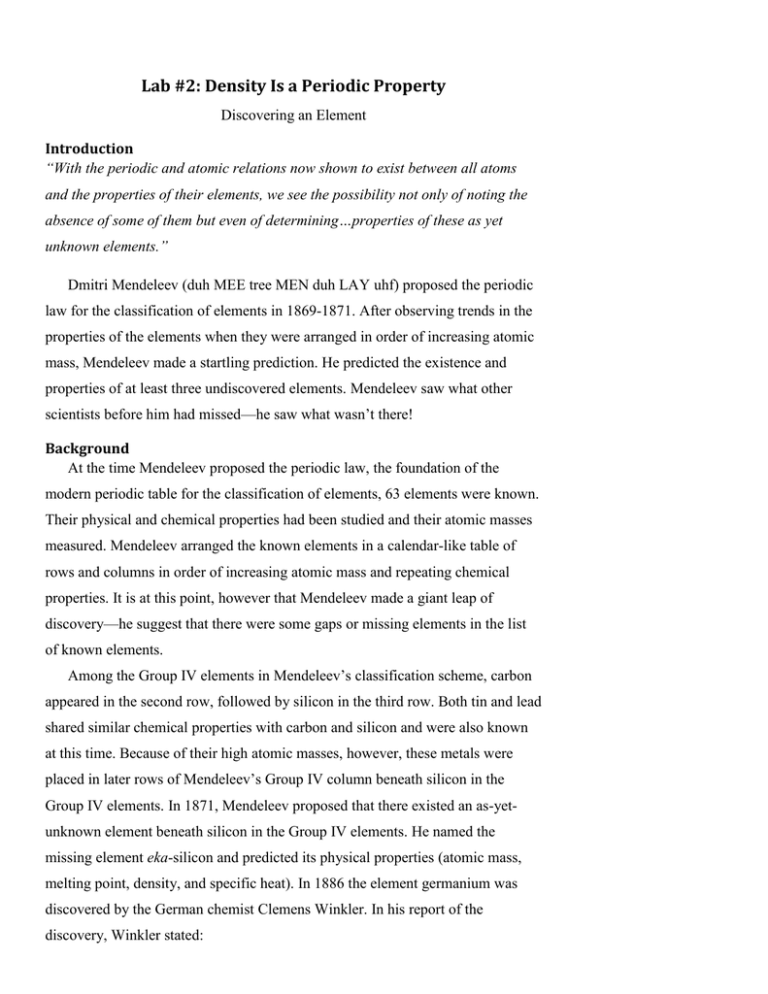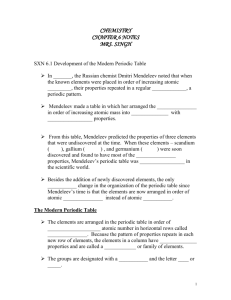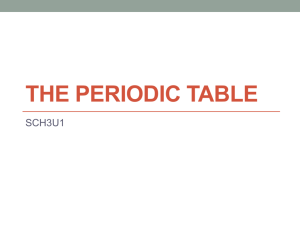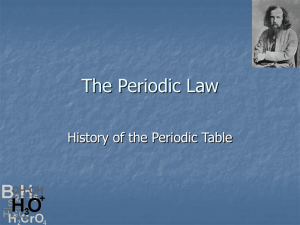File - RHS Chemistry
advertisement

Lab #2: Density Is a Periodic Property Discovering an Element Introduction “With the periodic and atomic relations now shown to exist between all atoms and the properties of their elements, we see the possibility not only of noting the absence of some of them but even of determining…properties of these as yet unknown elements.” Dmitri Mendeleev (duh MEE tree MEN duh LAY uhf) proposed the periodic law for the classification of elements in 1869-1871. After observing trends in the properties of the elements when they were arranged in order of increasing atomic mass, Mendeleev made a startling prediction. He predicted the existence and properties of at least three undiscovered elements. Mendeleev saw what other scientists before him had missed—he saw what wasn’t there! Background At the time Mendeleev proposed the periodic law, the foundation of the modern periodic table for the classification of elements, 63 elements were known. Their physical and chemical properties had been studied and their atomic masses measured. Mendeleev arranged the known elements in a calendar-like table of rows and columns in order of increasing atomic mass and repeating chemical properties. It is at this point, however that Mendeleev made a giant leap of discovery—he suggest that there were some gaps or missing elements in the list of known elements. Among the Group IV elements in Mendeleev’s classification scheme, carbon appeared in the second row, followed by silicon in the third row. Both tin and lead shared similar chemical properties with carbon and silicon and were also known at this time. Because of their high atomic masses, however, these metals were placed in later rows of Mendeleev’s Group IV column beneath silicon in the Group IV elements. In 1871, Mendeleev proposed that there existed an as-yetunknown element beneath silicon in the Group IV elements. He named the missing element eka-silicon and predicted its physical properties (atomic mass, melting point, density, and specific heat). In 1886 the element germanium was discovered by the German chemist Clemens Winkler. In his report of the discovery, Winkler stated: “…There can be no longer any doubt that the new element is no other than the eka-silicon prognosticated fifteen years ago by Mendeleev.” Within 15 years of Mendeleev’s prediction of the existence of missing elements, three of the elements had been discovered, their properties in excellent agreement with those predicted by Mendeleev. Is it possible to recreate some of the excitement that followed the prediction and discovery of Mendeleev‘s missing elements? Experiment Overview The purpose of this experiment is to measure mass and volume data for silicon, tin, and lead, calculate their densities, and use these results to predict the density of germanium, Mendeleev’s “undiscovered” element in the Group IV family of elements. The volume of the elements will be measured by water displacement. Prelab Questions 1. One of the elements Mendeleev predicted was eka-aluminum, corresponding to a gap in the fourth row or period of the Group IIIA elements, between aluminum and indium. The density of aluminum (period 3) is 2.70, that of indium (period 5) 7.31, and that of thallium (period 6) 11.85 g/cm3. Make a graph of period number on the x-axis versus density on the y-axis for each of these elements. 2. Use your graph to predict the density of eka-aluminum. What known element in the modern Periodic Table corresponds to eka-aluminum? 3. How do the actual and predicted density values compare? You have to look up the actual density for the element you named #2! Use the following equation to calculate the percent error between the predicted and actual values for the density of eka-aluminum. (Note: The actual density of this element is 5.90 g/cm3). 𝑝𝑒𝑟𝑐𝑒𝑛𝑡 𝑒𝑟𝑟𝑜𝑟 = |𝑎𝑐𝑡𝑢𝑎𝑙 − 𝑝𝑟𝑒𝑑𝑖𝑐𝑡𝑒𝑑| 𝑥 100% 𝑎𝑐𝑡𝑢𝑎𝑙





